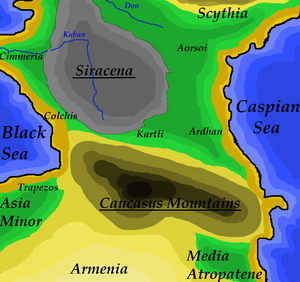Bosporan Civil War
| Bosporan Civil War | |||||||
|---|---|---|---|---|---|---|---|
| Part of Bosporan Civil War | |||||||
|
|||||||
| Belligerents | |||||||
| The Siraceni |
Bosporans Scythians |
||||||
| Commanders and leaders | |||||||
|
Eumelos Aripharnes |
Satyros II † Meniscus Prytanis † |
||||||
| Strength | |||||||
| 42,000 | 34,000 | ||||||
| Casualties and losses | |||||||
| High | Medium | ||||||
Siracen victory
The Bosporan Civil War or the First Bosporan Civil War was a dynastic dispute from 310 to 309 BC between the sons of Paerisades I. These sons were Satyros II, who inherited the kingdom as he was the eldest, Eumelos, who was a claimant to the throne, and Prytanis, who engaged in battle later on.
Paerisades, one of the sons of Leukon I, died in 310 BC after having ruled 38 years; his eldest son, Satyros II, inherited the kingdom from his father. Eumelos was not pleased with this, and fled Panticapaeum and was given refuge by the ruler of the Sarmatian tribe of Siraces, Aripharnes. After gathering a large army and making an alliance with the neighboring barbarians, Eumelos became a claimant to the Bosporan throne. Upon hearing this, Satyrus immediately left Panticapaeum under Prytanis and sallied out against his brother, cornering him with his baggage wagons in the banks of the river Thatis with Aripharnes.
The Scythians partook in this war because their rivals, the Siraceni, were trying to gain influence in the Bosporus and possibly take some of the land of the Scythians. It is very likely that the mercenaries employed by Satyrus were recruited from Bosporan cities. For some unknown reason, Satyros did not use the citizen Bosporan army, probably due to there being shifting allegiances, and instead left them to protect the cities.
It is important to note that the Scythians and Sarmatians were most likely competing for influence and territory.
Satyrus mobilized his army into battle formations, placing himself in the center in a phalanx formation. He had stationed his Greek mercenaries and Thracian peltasts to his right, and his Scythian allies to his left. Satyrus rounded his best troops and charged at Aripharnes, who was opposite him, in the center of the enemy line. The two sides sustained many losses, but Satyrus was able to rout Aripharnes and he gave chase to kill the fleeing enemy but stopped when he received news that his brother Eumelos was winning at the right wing, and that his mercenaries had begun to flee. He turned around and aided his own troops and was able to route his brother's entire army.
...
Wikipedia

